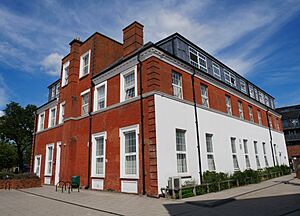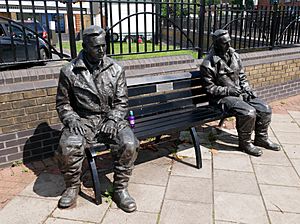Crayford facts for kids
Quick facts for kids Crayford |
|
|---|---|
 |
|
| Population | 11,226 (2011 Census. Ward) |
| OS grid reference | TQ515745 |
| • Charing Cross | 13.7 mi (22.0 km) WNW |
| London borough | |
| Ceremonial county | Greater London |
| Region | |
| Country | England |
| Sovereign state | United Kingdom |
| Post town | DARTFORD |
| Postcode district | DA1 |
| Dialling code | 01322 |
| Police | Metropolitan |
| Fire | London |
| Ambulance | London |
| EU Parliament | London |
| UK Parliament |
|
| London Assembly |
|
Crayford is a lively town in South East London, part of the London Borough of Bexley. It is located near Bexleyheath and Dartford. Long ago, Crayford was part of Kent county until 1965. The town grew up around the River Cray, named after an old river crossing (a 'ford') that isn't used anymore.
Contents
History of Crayford
Early Settlements and Battles
People lived in the Crayford area a very long time ago, even before the Romans arrived. Around 30 BC to AD 40, there was an Iron Age settlement near where St Paulinus Church stands today. Later, Roman ruins were found here. Some historians think Crayford might have been a Roman town called Noviomagus Cantiacorum.
Crayford is also famous for a big battle that happened in 457 AD. This was the battle of Crecganford, where a leader named Hengist defeated Vortimer. This victory helped Hengist become a powerful ruler in Kent. The story of this battle was written down about 400 years later in the Anglo-Saxon Chronicle.
Crayford in the Domesday Book
Crayford is mentioned in the Domesday Book, a very old record made in 1086. It shows that Crayford was a small settlement with a church and three mills. It had about 27 families living there. At that time, the land belonged to Christ Church, Canterbury, not a private person or the king.
Old Industries and Manor Houses
For many centuries, Crayford was known for making bricks. It was also a place where silk scarves, ties, and other fabrics were printed. For a short time, carpets were made here too.
There were several important houses in Crayford long ago. Hall Place, which is still here today, was built around 1537 for a rich man named John Champneis. There was also an iron mill that later became a saw mill. This saw mill even produced the wood for the floor of Buckingham Palace in London!
Growing Industries
In 1819, the old saw mill became a flour mill. Another big employer was a silk factory started by Augustus Applegath. Later, the Maxim Nordenfeldt Gun and Ammunition Factory became a major workplace. This factory was taken over by the Vickers Company in 1897.
Vickers became the biggest employer in Crayford. They built military airplanes and weapons. They even built homes, a theatre, and a canteen for their workers. The canteen, built during the First World War, later became the Crayford Town Hall.
Another important company in Crayford was Dussek Brothers, which made oils and waxes. Their factory closed in 2001. The David Evans silk works also closed in 2002.
People of Crayford
According to the 2011 census, most people living in Crayford are White British.
Fun Things to Do in Crayford
Crayford has a theatre where you can watch shows. There's also a greyhound racing track for dog races. The theatre is named after Geoffrey Whitworth, who helped develop amateur drama in Britain. The Crayford Community Centre, located above the library, is a place for many local groups to meet.
Nearby, Hall Place is a historic site with beautiful gardens. The River Cray flows through these gardens. You can also find a plant nursery, a cafe, and a shop there.
The large Sainsbury's supermarket in Crayford is very modern. It uses special technology to heat the store with natural energy from deep underground. When it was expanded in 2010, it was the largest Sainsbury's in England!
The Tower Retail Park is a shopping area across from Crayford Town Hall. The High Street in Crayford is partly one-way for cars.
Sports in Crayford
- VCD Athletic Football Club is a local football team that plays in the Isthmian League Premier Division. Their home stadium is Oakwood, which they share with Kent Football United.
- Crayford Arrows Sports Club is another local football team, started in 1981.
- Speedway racing used to happen at Crayford Greyhound Stadium. The local team was first called the Highwaymen and later the Kestrels. The track eventually closed, and the team moved to Hackney.
Schools in Crayford
- A main secondary school in the area is Haberdashers' Crayford Academy.
Places to Worship
- Acts 2 Church Crayford, at Haberdashers' Aske's Academy
- Crayford Baptist Church, on Bexley Lane
- St Paulinus Church (Anglican), on Manor Road
- St Mary of the Crays Catholic Church, on Old Road
- Crayford Mosque, on Crayford High Street
Nearby Places

- Bexleyheath
- Dartford
- Barnes Cray
- Slade Green
- Barnehurst
- Erith
- Bexley
Getting Around Crayford
Trains
Crayford railway station connects the town to other places. You can catch Southeastern trains to:
- London Charing Cross (via Sidcup)
- London Cannon Street (via Sidcup and Lewisham)
- London Cannon Street (via Woolwich Arsenal and Greenwich)
- Dartford
- Gravesend
Buses
Crayford has three Transport for London bus services:
- Route 96: Goes to Woolwich (via Bexleyheath and Welling) and to Bluewater (via Dartford).
- Route 428: Goes to Erith and to Bluewater (via Dartford).
- Route 492: Goes to Sidcup (via Bexleyheath) and to Bluewater (via Dartford).
Famous People from Crayford
- Semi Ajayi: A footballer who plays for West Bromwich Albion and the Nigeria national football team.
- Augustus Applegath: An inventor who lived in Crayford.
- Algernon Blackwood: An author and journalist who lived in Crayford Manor House.
- William Claiborne: An important surveyor in early American history.
- Thomas Harman: An author who lived in Crayford.
- Keith and Gavin Peacock: A father and son who both became footballers.
- Cloudesley Shovell: A famous admiral who lived at May Place.
- Hiram Maxim: An inventor who lived in Crayford.
- Derek Ufton: Played cricket for Kent and football for Charlton Athletic.
- Jack Wall: The inventor of the Crayford focuser, a part used in telescopes.
Images for kids








